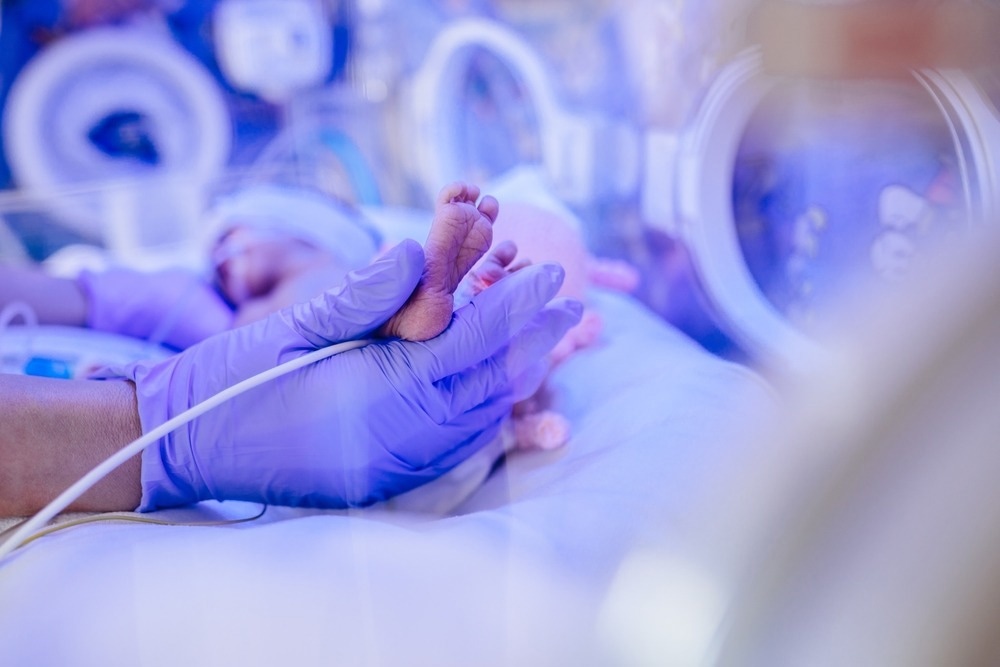In a recent case report published in the Pediatrics journal, researchers described two coronavirus disease 2019 (COVID-19) -infected neonate cases exhibiting early-onset seizures and acquired microcephaly over time.

Study: Maternal SARS-CoV-2, Placental Changes and Brain Injury in 2 Neonates. Image Credit: IrynaInshyna/Shutterstock.com
Background
The severe acute respiratory syndrome coronavirus 2 (SARS-CoV-2) outbreak has negatively impacted global health and led to poorer fetal and maternal outcomes. Examples include:
Two infants were born in the third trimester to mothers who tested COVID-19-positive before delivery and experienced a severe neurologic injury. The infants showed neurological damage and developmental impairments.
One infant suffered a sudden death aged 13 months and had significant brain damage, including loss of white matter, vacuolization, and gliosis, as determined during autopsy.
This study aimed to provide evidence to highlight that mid-trimester SARS-CoV-2 infection can infect the placenta and the fetal brain, triggering inflammatory events associated with major brain injury.
Case report 1: preterm infant
A Hispanic male infant was delivered via Cesarean section to a 21-year-old multigravida at a gestational age of 32 weeks.
At 27 weeks of gestation, the mother was diagnosed with SARS-CoV-2 after being admitted to the intensive care unit (ICU) due to multisystem disease and pneumonia tested by nasopharyngeal swab reverse transcription polymerase chain reaction (NP RT-PCR). The fetal monitoring and ultrasound assessments were consistently normal.
A cesarean section was performed for maternal indications at 32 weeks of gestation after administering antenatal corticosteroids to facilitate fetal lung maturation.
By this time, the mother tested negative for SARS-CoV-2. The newborn had Apgar scores of four at one minute and seven at five minutes, and an umbilical cord arterial blood gas has a pH of 7.22, pCO2 of 97 mm Hg, and base excess of +11. The infant showed seizure-like activity and difficulty breathing, leading to the need for intubation along with assisted ventilation.
Vasopressors were used to treat early hypotension and biventricular systolic depression detected by echocardiography. The lung disease remained despite the early administration of broad-spectrum antibiotics and surfactants.
The bilateral confluent densities noted on initial chest radiography did not fully resolve post-respiratory recovery. The infant tested negative for SARS-CoV-2 via NP RT-PCR at 24 hours of age.
The infant presented COVID-19 immunoglobulin (Ig)-G and combined IgA, IgM, and IgG reactivity towards a recombinant SARS-CoV-2 spike protein derivative and elevated levels of cytokines and inflammatory markers in their blood.
The infant's seizures were resolved, and antiepileptics were stopped. However, the infant had to be readmitted multiple times due to respiratory infections and failure to thrive.
The patient's 12-month neurologic examination showed persistent abnormalities, including head lag, elevated appendicular tone, truncal hypotonia, delayed developmental features, and hyperreflexia. The child experienced an upper respiratory infection and visited the emergency department at 13 months old.
The infant was found unresponsive in bed by his mother three days later. Paramedics arrived and found the infant in asystolic cardiac arrest but could not revive him.
Case report 2: full-term infant
A Hispanic female infant with a gestational age of 39 weeks was born to a 20-year-old first-time mother. The mother had tested positive for asymptomatic SARS-CoV-2 in the second trimester but later tested negative.
The mother tested positive for COVID-19 during vaginal delivery, despite being asymptomatic. The newborn received Apgar scores of four at one minute and six at five minutes and revealed an umbilical cord arterial blood gas with a pH of 7.22, pCO2 of 47 torrs, and base deficit of 10.
The patient needed nasal continuous positive airway pressure to treatapnea and was treated with antibiotics for suspected sepsis. The physical examination showed mild hypotonia.
Clinical seizures were verified on continuous conventional electroencephalography when the infant was 16 hours old. The infant's 24-hour SARS-CoV-2 RT-PCR tested negative. However, their SARS-CoV-2 immunoglobin G (IgG); combined IgA, IgG, and IgM reactivity against a SARS-CoV-2 spike recombinant derivative, cytokines, and inflammatory markers were significantly elevated.
Diffuse-restricted diffusion characterized by a low apparent diffusion coefficient was observed across the supratentorial brain as per the brain magnetic resonance imaging (MRI) taken on day four, while the medial temporal and basal ganglia lobes were spared.
The patient was discharged aged five weeks but was readmitted to the hospital multiple times due to seizures and respiratory infections. At 12 weeks of age, a repeated brain MRI revealed a worsening of severe cystic encephalomalacia.
At one year of age, the patient's follow-up exam revealed microcephaly, considerable neurodevelopmental delay, and abnormal neurologic assessment.
The patient also showed low axial tone, elevated appendicular tone, head lag, clonus, and hyperreflexia and could not roll over or sit without support. Currently, the infant is receiving hospice care.
Conclusion
The study findings showed that maternal SARS-CoV-2 infection during mid-trimester can lead to infection in the placenta and infant or fetal brain, causing inflammation in both.
Infants beyond the neonatal period may experience progressive neurologic issues and major brain injury.
Further research is required to investigate how the timing of in-utero COVID-19 affects placental inflammation and the potential long-term effects on the developing brain.